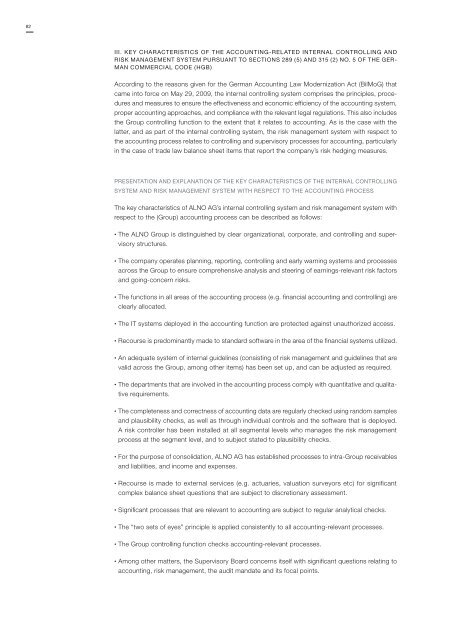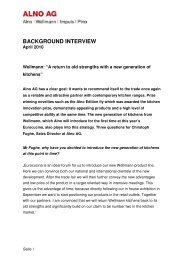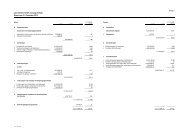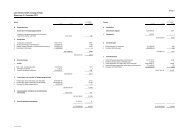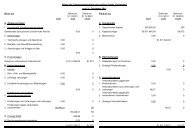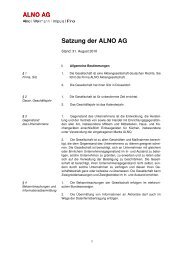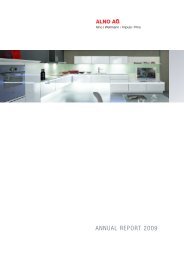100 % FUTURE - ALNO
100 % FUTURE - ALNO
100 % FUTURE - ALNO
You also want an ePaper? Increase the reach of your titles
YUMPU automatically turns print PDFs into web optimized ePapers that Google loves.
82<br />
III. KEY CHARACTERISTICS OF THE ACCOUNTING-RELATED INTERNAL CONTROLLING AND<br />
RISK MANAGEMENT SYSTEM PURSUANT TO SECTIONS 289 (5) AND 315 (2) NO. 5 OF THE GER-<br />
MAN COMMERCIAL CODE (HGB)<br />
According to the reasons given for the German Accounting Law Modernization Act (BilMoG) that<br />
came into force on May 29, 2009, the internal controlling system comprises the principles, procedures<br />
and measures to ensure the effectiveness and economic efficiency of the accounting system,<br />
proper accounting approaches, and compliance with the relevant legal regulations. This also includes<br />
the Group controlling function to the extent that it relates to accounting. As is the case with the<br />
latter, and as part of the internal controlling system, the risk management system with respect to<br />
the accounting process relates to controlling and supervisory processes for accounting, particularly<br />
in the case of trade law balance sheet items that report the company’s risk hedging measures.<br />
PRESENTATION AND EXPLANATION OF THE KEY CHARACTERISTICS OF THE INTERNAL CONTROLLING<br />
SYSTEM AND RISK MANAGEMENT SYSTEM WITH RESPECT TO THE ACCOUNTING PROCESS<br />
The key characteristics of <strong>ALNO</strong> AG’s internal controlling system and risk management system with<br />
respect to the (Group) accounting process can be described as follows:<br />
• The <strong>ALNO</strong> Group is distinguished by clear organizational, corporate, and controlling and supervisory<br />
structures.<br />
• The company operates planning, reporting, controlling and early warning systems and processes<br />
across the Group to ensure comprehensive analysis and steering of earnings-relevant risk factors<br />
and going-concern risks.<br />
• The functions in all areas of the accounting process (e.g. financial accounting and controlling) are<br />
clearly allocated.<br />
• The IT systems deployed in the accounting function are protected against unauthorized access.<br />
• Recourse is predominantly made to standard software in the area of the financial systems utilized.<br />
• An adequate system of internal guidelines (consisting of risk management and guidelines that are<br />
valid across the Group, among other items) has been set up, and can be adjusted as required.<br />
• The departments that are involved in the accounting process comply with quantitative and qualitative<br />
requirements.<br />
• The completeness and correctness of accounting data are regularly checked using random samples<br />
and plausibility checks, as well as through individual controls and the software that is deployed.<br />
A risk controller has been installed at all segmental levels who manages the risk management<br />
process at the segment level, and to subject stated to plausibility checks.<br />
• For the purpose of consolidation, <strong>ALNO</strong> AG has established processes to intra-Group receivables<br />
and liabilities, and income and expenses.<br />
• Recourse is made to external services (e.g. actuaries, valuation surveyors etc) for significant<br />
complex balance sheet questions that are subject to discretionary assessment.<br />
• Significant processes that are relevant to accounting are subject to regular analytical checks.<br />
• The “two sets of eyes” principle is applied consistently to all accounting-relevant processes.<br />
• The Group controlling function checks accounting-relevant processes.<br />
• Among other matters, the Supervisory Board concerns itself with significant questions relating to<br />
accounting, risk management, the audit mandate and its focal points.


